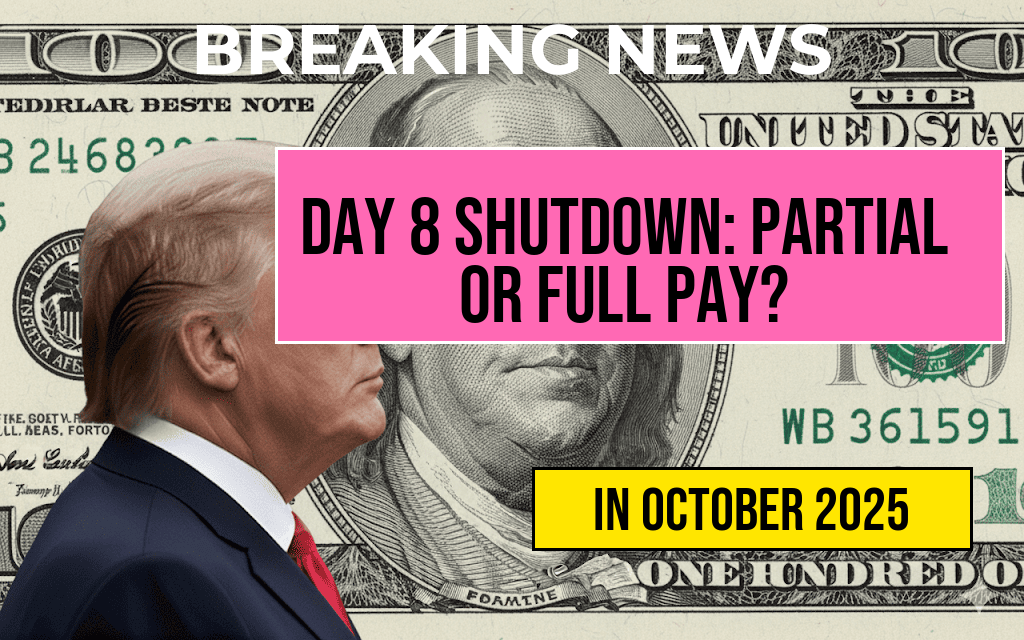As the federal government enters its eighth day of shutdown amid ongoing budget negotiations, thousands of federal employees face increasing financial uncertainty. With no clear resolution in sight, questions abound regarding whether these workers will receive partial payments or their full salaries. While some government agencies have implemented emergency measures to ease the financial strain, many federal employees remain uncertain about their paychecks. The situation has sparked widespread concern among workers, advocacy groups, and policymakers alike, emphasizing the urgent need for a swift resolution to reopen the government and safeguard the livelihoods of those affected.
Federal Shutdown Extends Into Day Eight with No End in Sight
The partial federal government shutdown, now entering its eighth day, continues to disrupt essential services and impact federal employees across the nation. The impasse stems from disagreements over federal spending bills, with Congress unable to reach a consensus on appropriations. As a result, approximately 800,000 federal workers remain furloughed or working without pay, raising alarms about their financial stability and the broader economic implications. Although some agencies have prioritized critical functions, most non-essential operations remain halted, and employees are anxiously awaiting clarity on their pay status.
How Are Federal Employees Being Affected?
Federal workers are divided into two categories based on their job functions: those deemed essential and required to work without pay, and those furloughed with no work and no pay. The Office of Personnel Management (OPM) has issued guidance to agencies, but the financial impact varies significantly depending on individual circumstances. Many employees are faced with difficult decisions, including delaying bills or seeking emergency assistance, as their paychecks are uncertain.
Will Federal Employees Receive Partial Payments?
Historically, during government shutdowns, some agencies have managed to provide partial payments or delayed full salaries once funding is restored, but this depends heavily on the legal and financial frameworks in place. Currently, the federal government has not officially announced plans to disburse partial payments during this shutdown. Instead, the focus remains on reopening the government and ensuring that employees are compensated in full once appropriations are approved.
Legal and Financial Considerations
Legal experts note that federal employees’ pay is protected under the Fair Labor Standards Act, which generally guarantees payment for work performed. However, during a shutdown, the absence of appropriations can complicate timely pay. Historically, Congress has authorized retroactive pay for federal workers after shutdowns conclude, though the delay can cause financial hardship. For example, during the 2018-2019 shutdown, employees received back pay once funding resumed, but many faced weeks of financial uncertainty.
Government Agencies’ Response and Support Measures
Some agencies have established emergency funds or provided guidance on managing expenses during the shutdown. The Federal Employee Education & Assistance Fund has offered resources to affected workers, emphasizing the importance of financial planning during periods without income. Additionally, certain federal contractors and supplemental programs may extend short-term aid, but these options are limited and vary by location and agency.
Implications for the Broader Economy
The shutdown’s ripple effects extend beyond federal employees, affecting contractors, local economies, and services relied upon by the public. Economists warn that prolonged shutdowns can slow economic growth, reduce consumer spending, and undermine public trust in government operations. The Congressional Budget Office (CBO) estimates that each week of shutdown costs the economy approximately $11 billion, highlighting the urgency of reaching an agreement.
What Comes Next?
With negotiations ongoing, the outlook remains uncertain. Lawmakers are under pressure from constituents and advocacy groups to reach a bipartisan agreement that reopens the government and ensures federal workers are paid. The Biden administration has reiterated its commitment to providing full pay once the shutdown ends, but political disagreements continue to stall progress.
Key Dates and Potential Developments
- Upcoming Deadline: Congressional leaders have indicated that discussions will intensify before the next funding expiration date, currently set for early February.
- Expected Actions: Possible temporary funding measures or a longer-term budget agreement could be introduced to break the impasse.
- Impact on Employees: Continued delays could lead to increased financial hardship, calls for emergency aid, and political pressure for resolution.
Summary Table of Federal Employee Pay Status During Shutdown
| Employee Category | Status During Shutdown | Pay Status |
|---|---|---|
| Essential Workers | Work Required | Pay delayed or retroactively paid |
| Furloughed Employees | No work required | No pay until funding resumes, but often received retroactive pay later |
| Contractors | Dependent on contract terms | Generally unpaid during shutdown, unless specified otherwise |
As negotiations continue, the situation remains fluid, with federal employees and the broader public awaiting decisive action. The impact of this prolonged shutdown underscores the critical need for sustainable government funding processes to prevent future disruptions.
For ongoing updates, sources like the Government Executive and the C-SPAN coverage provide authoritative insights into the shutdown’s developments.
Frequently Asked Questions
Will federal employees receive any payment on day 8 of the shutdown?
Federal employees are currently facing uncertainty, with partial payments being a possibility depending on government funding decisions. However, many employees have yet to receive their full salaries.
What factors determine whether federal employees get partial payments or full salaries?
The availability of funds and government shutdown negotiations directly influence whether partial payments or full salaries are issued to federal employees.
How long could the shutdown last, and what are the implications for employee pay?
The duration of the shutdown remains uncertain, which could lead to extended pay delays for federal employees if a resolution is not reached soon.
Are there any government programs or resources available to affected federal employees?
Some support programs and resources may be available for federal employees experiencing financial hardship during the shutdown, including emergency loans and financial counseling.
What steps can federal employees take to prepare for potential pay delays?
Federal employees are advised to review their financial plans, prioritize expenses, and explore emergency funds or assistance options to manage during the shutdown.






